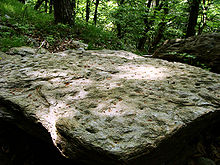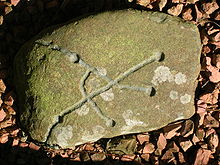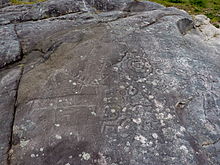- Cup and ring mark
-
 Large cup and ring petroglyph at the 'Laxe das Rodas', Galicia, where hundreds of stations are known.
Large cup and ring petroglyph at the 'Laxe das Rodas', Galicia, where hundreds of stations are known.

A replica of an unusual cup-and-ring-marked stone from Dalgarven, North Ayrshire, Scotland.  Coppelle, Val Camonica, Italia
Coppelle, Val Camonica, Italia Deer and cup-and-ring motifs, Tourón, Ponte Caldelas, Galicia.
Deer and cup-and-ring motifs, Tourón, Ponte Caldelas, Galicia.
Cup and ring marks or cup marks are a form of prehistoric art found mainly in Atlantic Europe (Northern England, Scotland,[1] Ireland, Brittany , Portugal and Galicia (North West Spain)[2]) and Mediterranean Europe (North West Italy, Thessalia Central Greece, Switzerland) although similar forms are also found throughout the world including Mexico, Brazil, Greece, and India,[3] where the oldest cup marks so far recorded are to be found in the Paeleolithic cave shelter site of Chattan.
They consist of a concave depression, no more than a few centimetres across, pecked into a rock surface and often surrounded by concentric circles also etched into the stone. Sometimes a linear channel called a gutter leads out from the middle.
The decoration occurs as a petroglyph on natural boulders and outcrops and also as an element of megalithic art on purposely worked megaliths such as the slab cists of the Food Vessel culture, some stone circles and passage graves such as the clava tombs and on the capstones at Newgrange.
Contents
Italy
Numerous cup marks have been discovered in Val Camonica (Italy) associated to rock drawings.
Many engraved blocks are visible in the north west region of Italy (Piedmont): The best known places are "Val Susa", "La Bessa"[4] and "Valchiusella".[5]
Galicia (Spain)
Similar patterns are known in Galicia,[6] which has given them the name of 'Galician style'. These types, the cup-and-ring, cup-and-ring with gutter and the gapped concentric circles motifs are shared between this part of Iberia and the British Isles, manifesting, together with other cultural expressions like megaliths or Bronze Age culture, a cultural link along the coasts of Atlantic Europe.[7]
United Kingdom
Precisely dating megalithic art is difficult as even if the megalithic monument can be dated, the art may be a later addition. The Hunterheugh Crags cup and ring marks near Alnwick in Northumberland have recently been demonstrated to date back into the Early Neolithic through their stratigraphic relationship with other, datable features. Some cup marks have been found in Iron age contexts but these may represent re-used stones.
Where they are etched onto natural, flat stone it has been observed that they seem to incorporate the natural surface of the rock. Those at Hunterheugh are mostly connected to one another by gutters that can channel rainwater from one to the next, down the sloping top of the stone.
It has been suggested by archaeologist Clive Waddington that the initial Early Neolithic impetus to create the marks was forgotten and that the practice fell into abeyance until a second phase of creation continued the basic tradition but with less precision and more variability in design. The markers of this second phase moved the art from natural stones to megaliths as its symbolism was reinterpreted by Later Neolithic and Early Bronze Age people.
Their purpose is unknown although some may be connected with natural stone outcrops exploited by Neolithic peoples to make polished stone axes. A religious purpose has been suggested.
Alexander Thom suggested on a BBC television documentary called "Cracking the Stone Age Code" in 1970, "I have an idea, entirely nebulous at the moment, that the cup and ring markings were a method of recording, of writing, and that they may indicate, once we can read them, what a particular stone was for. We have seen the cup and ring markings on the stone at Temple Wood, and that's on the main stone but we can't interpret them ...yet".[8] He created diagrams and carried out analysis of over 50 of the cup and ring markings from which he determined a length he termed the Megalithic Inch (MI).[9] This whole idea has been ignored almost completely apart from a critical analysis carried out by Alan Davies in the 1980s, who covered only English sites with cup and ring marks. He suggested "strongest indications... ...towards the use of a quantum close in value to 5 MI at certain sites" and that "the apparent quantum seems strongly associated with ringed cups".[10] Davies made an initial effort to build on Thom's start, and to answer the question he posed; "Why should a man spend hours - or rather days - cutting cups in a random fashion on a rock? It would indeed be a breakthrough if someone could crack the code of the cups."[10]
Other examples of sites with cup and ring marks include :
- Chatton Sandyford cairn and Fowberry petrogyphs in Northumberland
- Backstone Beck petroglyphs on Ilkley Moor
- Gardom's Edge in Derbyshire
- Bachwen portal dolmen in North Wales
- Anderton, Lancashire
- Dalladies long barrow, Kincardineshire
- Street House cairn in Cleveland
- Dalgarven Mill, North Ayrshire
- Mauchline Gorge, East Ayrshire
- Brodick, Isle of Arran
- Blackshaw Hill, North Ayrshire
- Kilmartin, Argyll
- Achnabreck, Argyll (Proc Soc Antiq Scot 1970-71)
- Balblair, Beauly, nr. Inverness
Ireland
Work at Drumirril in County Monaghan has uncovered Neolithic and early Bronze Age occupation evidence around the rock carvings there and this dating is generally accepted for most of the art. Another particularly rich source of cup marked boulders is the Derrynablaha townland on the Iveragh peninsula in county Kerry.
Greece
See also
- Rock Drawings in Valcamonica
- European Megalithic Culture
- Petroglyph
- Petrosomatoglyph
- Dalgarven Mill
- Bullaun
References
- ^ http://www.cupstones.f9.co.uk/whatrcr.htm
- ^ http://www.whithorn.com/history-local-sites.asp?localsiteID=6
- ^ Francis Scott Elliot, George (1915). Prehistoric Man and his story. Seeley, Service. p. 398.
- ^ Rock art and cup marks of Bessa
- ^ Arte Rupestre della Valchiusella - Chiusella Valley Rock Art
- ^ R. Bradley et al., Rock art and the prehistoric Landscape of Galicia...
- ^ M. Stewart, Strath Tay in the Second Millennium BC. A Field Survey.
- ^ The Spectator, p. 608. 1970. http://books.google.com/books?id=oBw-AQAAIAAJ. Retrieved 28 April 2011.
- ^ Systematics: The Journal of the Institute for the comparative study of History, Philosophy and the Sciences, Vol. 6, Number 3, Coombe Spring Press., December 1968
- ^ a b Alan Davies in Clive Ruggles (13 February 2003). Records in Stone: Papers in Memory of Alexander Thom. Cambridge University Press. pp. 392–422. ISBN 9780521531306. http://books.google.com/books?id=oZ3JGYd1kJoC&pg=PA422. Retrieved 30 April 2011.
Further reading
- Beckensall, Stan and Laurie, Tim. 1998. Prehistoric Rock Art of County Durham, Swaledale and Wensleydale. County Durham Books. ISBN 1-897585-45-4
- Beckensall, Stan. 2001. Prehistoric Rock Art in Northumberland. Tempus Publishing. ISBN 0-7524-1945-5
- Beckensall, Stan. 2002. Prehistoric Rock Art in Cumbria. Tempus Publishing. ISBN 0-7524-2526-9
- Butter, Rachel. 1999. Kilmartin. Kilmartin House Trust. ISBN 0-9533674-0-1
- Hadingham, Evan. 1974. Ancient Carvings in Britain; A Mystery. Garnstone Press. ISBN 0-85511-391-X
- Morris, Ronald W.B. 1977. The Prehistoric Rock Art of Argyll. Dolphin Press. ISBN 0-85642-043-3
- Proc. Soc. Antiq. Scot. 1970-71. Vol.103. Pps.33-56.
- Papanikolaou Stelios. 600 Written Rocks. Channels of primeval knowledge Larissa <<ella>> Second Revised Edition 2005 spapinvest@yahoo.gr ISBN 960-8439-21-3
External links
- British Rock Art Collection
- Era – England's Rock Art (Currently only covers Northumberland and County Durham)
- Rockart – Web Access to Rock Art: the Beckensall Archive of Northumberland Rock Art – University of Newcastle Upon Tyne
- El Laberinto Atlántico - Galician Rock Art
- BBC Archive - Chronicle | Cracking the Stone Age Code
Categories:- History of Northumberland
- Prehistoric art
- Stone Age Europe
Wikimedia Foundation. 2010.





